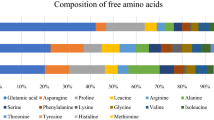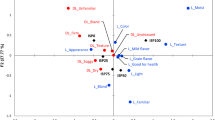Abstract
Enzymatically hydrolyzed vegetable protein was produced from soy protein using hydrolysis times of 0–20 h. The development of sensory properties and the pattern of protein degradation was followed. Around two-thirds of the final amount of free amino acids and degree of hydrolysis (DH) were achieved during the first 4 h of hydrolysis. Between 6 h and 10 h of hydrolysis the bouillon-like tastes increased significantly (P<0.001). In this time interval the amount of free amino acids exceeded 40% of the total amino acids and the DH exceeded 50% of the theoretically possible (100%). Using partial least squares regression with standardisation of free amino acid data according to their taste threshold values showed that free glutamic acid, aspartic acid and lysine correlated with the bouillon-like tastes. By standardisation of free amino acid data with respect to their SD the specificity of the enzymes for amino acid side-chains could be seen.
Similar content being viewed by others
Author information
Authors and Affiliations
Additional information
Received: 23 March 1998 / Revised version: 28 May 1998
Rights and permissions
About this article
Cite this article
Aaslyng, M., Larsen, L. & Nielsen, P. Development of chemical and sensory characteristics during enzymatic hydrolysis of soy. Z Lebensm Unters Forsch 208, 50–56 (1999). https://doi.org/10.1007/s002170050374
Issue Date:
DOI: https://doi.org/10.1007/s002170050374




